1958 French Grand Prix race report: Hawthorn's first GP win in four years
Ferrari's Mike Hawthorn dominates the field to finish ahead of Moss and von Trips; Fangio finishes fourth in his final race

Juan Manuel Fangio in his Maserati 250F leads Stirling Moss in his Vanwall.
Motorsport Images
IF any spectator has the feeling that he is being starved of motor racing then he should pay a visit to Reims at the time of the French Grand Prix. This year there was a 12-Hour race for Gran Turismo cars, a 30-lap race for Formula 2 cars and a 50-lap race for Formula 1 cars, the last event being the 44th French Grand Prix and being France’s contribution to the World Championship series. Altogether there were nearly 15 1/2 hours of continuous racing plus three afternoons and evenings before the weekend for practice, so that anyone who feels that there is too much racing at some English events can rest assured that for real endurance a visit to Reims is well worth while.
Qualifying
Practice started on Wednesday afternoon, the F2 cars going out first and main interest centred around the RRC Walker stable who has two Coopers fitted with fully-enveloping bodywork, with Moss trying both of them. Bridger and Lewis-Evans were sharing the Pa Moss-Gregory partnership. Cooper and Salvadori and Brabham were out in the works Coopers, while McLaren and Burgess were running with the Sorbiton team, the former driving CT Atkins’ car.
Of the Lotus opposition only Allison turned out, making a very brief appearance in one of the 1957 cars before magneto trouble stopped him. The only thing that stopped practice looking like a Brands Hatch meeting was the lone works Ferrari Dino 156, driven by Collins in view of the strong opposition from the English teams. The 1957 race record stood at 2min 38.2sec and Moss soon improved on this with the streamlined Cooper, recording 2min 37.7sec, but none of the others could approach it.
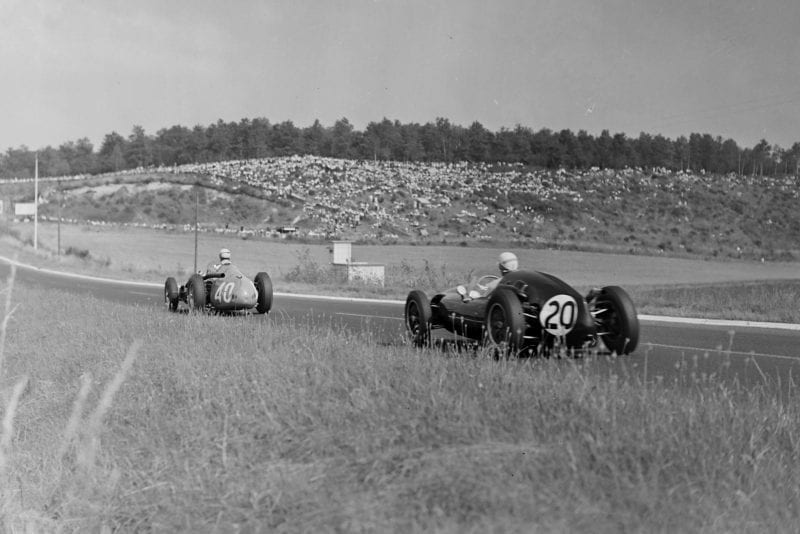
Chico Godia-Sales, Maserati 250F leads Roy Salvadori in his Cooper T45 Climax.
Motorsport Images
Immediately the F2 cars had finished their practice the F1 cars appeared, the Scuderia Ferrari with one hack car and Vanwall with four cars, while BRM brought out three 1958 cars, one being absolutely brand new. There was a remarkable air of confidence in the Ferrari team and as soon as the announcer said the circuit was open for practice, Hawthorn shot away in the hack Ferrari. The lap record stood to Fangio (Lancia/Ferrari) since 1956 with 2min 25.8sec though in practice last year he had recorded 2min 22.9sec with a Maserati. Hawthorn soon got himself wound up and his lap times came down in quick succession until he reached 2min 23.9sec, and at that he stopped, content to have set a good target for the British teems to aim at.
All this was done almost before the Vanwall and BRM drivers were ready to go out. Moss, Brooks and Lewis-Evans all joined in the fray but it was patently clear that the Vanwall was just not fast enough, and comparing the drag of the Vanwall and Ferrari, it seemed that the Maranello claim for something like 280bhp could not be far wrong, assuming the Vanwall to have 265 bhp.
“Schell suddenly surprised everyone, not least himself, by putting in a lap at 2min 23.1sec, a new fastest time for the evening”
Until Spa a few weeks ago the Ferraris had never been on a fast circuit, where power really counts, the races in the early part of this year all being on little fiddly circuits, but now they were coming into their own.
Schell suddenly surprised everyone, not least himself, by putting in a lap at 2min 23.1sec, a new fastest time for the evening, and the only explanation BRM could give was that they must have built a really good engine into that car. The Reims circuit is an interesting “car-circuit,” calling for maximum speed, acceleration and braking, for in the 8.3 kilometre circuit there is only one corner calling for driving skill of a high order, the others being full-throttle, or hairpins, so that the driver does not count for much and there is not much opportunity for one driver to outshine another.

Stirling Moss blast by in a Vanwall.
Motorsport Images
Musso then took out the hack Ferrari, but before he really got going there was a puff of smoke and he stopped out on the circuit. Of the Vanwalls Moss was fastest, and on his car was tried a system of bracing struts between the top of the kingpin and the chassis frame, in an endeavour to overcome front-wheel flutter that he had complained about at Spa. The only other cars out on this first evening of practice was Brabham with a Cooper and Hill with an old-type Lotus, and the session ended with FTD standing to Schell.
On Thursday evening it all started again and this time everyone seemed to be out, the track becoming quite crowded at times. Again the F2 cars started off, and Coopers were driven by da Silva Ramos, Burgess, Marsh, Brabham, Trintignant, Moss, Naylor, McLaren, Guelfi, Bridger, Salvadori, Wicken, Taylor, Goethals and Gibson, in fact, almost the whole of Surbiton’s production output. So unconvinced of their aerodynamic abilities were the Walker team, that the Moss car was now running in normal Cooper form, and he went faster than with all the fairings, but whether because of technical reasons or because the driver tried harder we shall never know.
Collins was out in to the Ferrari again, and new interest appeared in the shape of a single-seater Porsche driven by Behra; it was actually a sports Porsche fitted with a central driving position. Hill was out in the old Lotus again and Leston was driving a brand new Lotus F2 owned by John Fischer. Now things began to warm up and Moss and Collins began to battle for fastest time honours, the old record being improved upon many times until finally Moss came out on top with 2min 35.8sec, Collins with 2min 36.7sec, and to show the Walker team were being serious, Trintignant took his streamlined car round in 2min 36.5sec. Not to be outdone Behra clocked 2min 37.4sec, having much more speed down the straights, but losing on acceleration due to unsuitable lower gear ratios. Hill was a shade faster in the works Lotus than Brabham in the works Cooper, but of course, neither of them could approach Moss, while McLaren and Henry Taylor were absolutely equal on times.
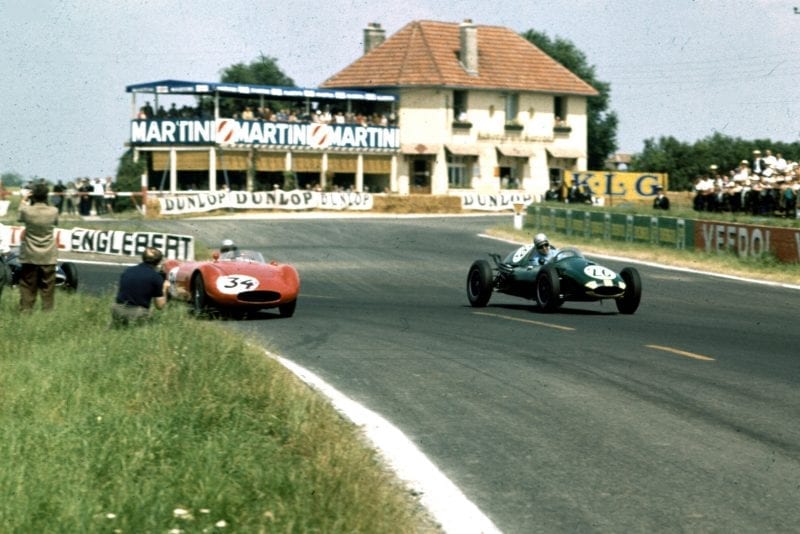
Henry Taylor in a Cooper T45-Climax leads John Fast in his OSCA.
Motorsport Images
The F1 practice for the French Grand Prix took on a more serious note, for Hawthorn, Musso and von Trips were all out, as were the full Vanwall team and Behra and Trintignant on BRMs, and private Maseratis turned out in the hands of Bonnier, Godia, Phil Hill, and a reputedly private one, but in fact a works car in the hands of none other than Fangio himself, this being the 1958 shorter and lighter car that Moss tried out at Nürburgring recently. Having got their proper team cars Ferrari now began to turn on the speed and Hawthorn was right on form, making faster time in 2min 21.7sec, while Musso followed him close with 2min 22.4sec.
The Vanwall team were very unhappy, for not only were the cars not fast enough but they were overheating and there was an air of gloom about the Acton team; Moss eventually got third fastest time with 2min 23.7sec but it was not very convincing. Behra was still out of the running, his car being nothing like as fast as that of Schell, while Trintignant was going round quietly. The new Maserati was a great disappointment, and though Fangio tried hard he could not approach the times of his rivals, his best being 2min 25.0sec, so the evening ended with Ferrari being highly elated, for Hawthorn’s time was not only best of practice so far but also the fastest ever recorded on the Reims circuit, his speed being 210.912kph.
“The new Maserati was a great disappointment, and though Fangio tried hard he could not approach the times of his rivals”
The final practice session took place on Friday evening, once more the F2 cars being first and this time Behra shook every body by recording 2min 34.0sec, a slight re-arrangement of the lower gears giving an enormous advantage away from the hairpin bends. Collins also showed a great improvement and got down to 2min 35.3sec, while Moss could not improve on his time of yesterday.
Both Walker-Coopers were now devoid of streamlining, all the work and expense having been completely wasted. Salvadori was fastest of the works Coopers but he could not approach the times of the Walker team, and neither could any of the Lotus cars, even though the Hornsey team produced their new Vanwall-like car, with offset transmission.
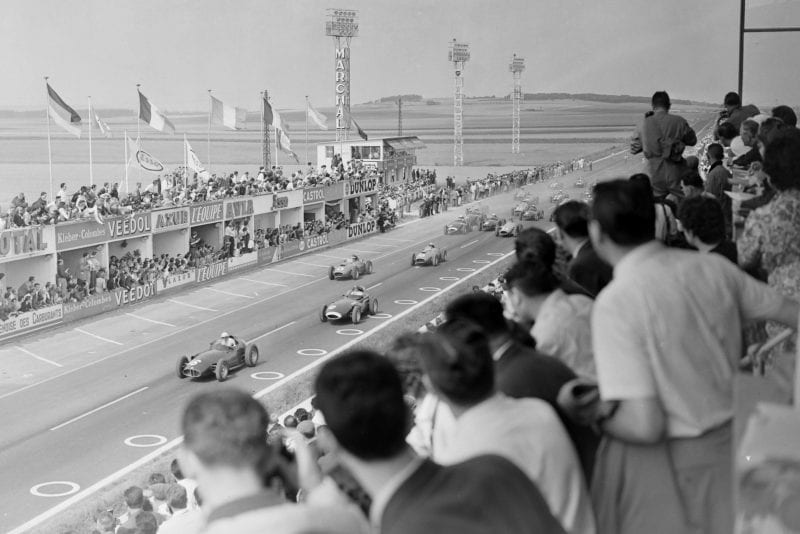
Harry Schell (BRM P25), Tony Brooks (Vanwall) Mike Hawthorn (Ferrari 246) and Luigi Musso, (Ferrari 246) at the start of the race.
Motorsport Images
When the F2 cars finally left the track everyone looked forward to Sunday’s race with interest for the front row of the grid decided on practice times contained Porsche, Ferrari and Cooper, with Behra, Collins and Moss as drivers, so that all ideas of F2 being a category for promising young drivers was put aside, this F2 race was merely going to be a watered down F1 race. Just before practice ended there was gloom in the Walker camp, for Trintignant’s car caught fire as he was leaving one of the hairpin bends, and though the driver escaped with slight burns on the neck, the car appeared to be badly damaged.
For the final F1 practice the Scuderia Centro-Sud now joined in with three cars, all looking rebuilt and immaculate and driven by Gerini, and the two Americans Shelby and Ruttman, the last-named a well-known Indianapolis driver, Fangio, Bonnier, Godia and Phil Hill were also on Maseratis, and Ferrari, Vanwall and BRM were all there, as were Cooper, while Lotus were busily finishing building the second of their 1958 cars. Nobody could improve on Hawthorn’s time of the day before and in fact, there seemed to have been reached a case of stalemate, with the Ferrari team sitting pretty.
Vanwalls could not find any more speed, and were still not happy about the overheating, BRM were not as fast as Ferrari but were fairly contented, and the Maserati private-owners were not doing anything startling either because they were new to the cars, like Shelby and Ruttman, or were flat-out all the way round and lacking speed like Phil Hill. It was interesting that this driver was finding he was very little faster in the GP car than he was in a Gran Turismo Ferrari coupé, as neither car was fast enough to do justice to the circuit. Trintignant broke down for the second time during the evening, this time in the BRM and Schell brought him back to the pits, and just before the end of practice there was a puff of smoke from the Vanwall Moss was driving and he coasted into the pits: a head had broken off a valve.
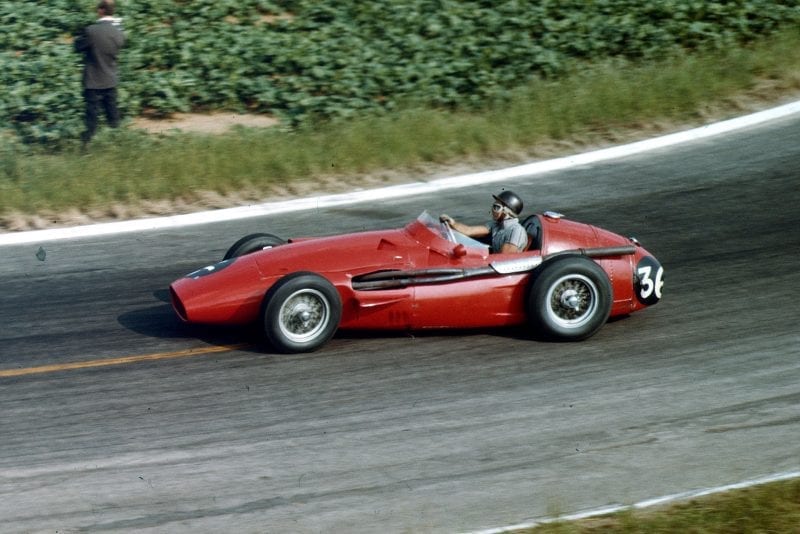
Phil Hill driving his Maserati 250F to 7th place.
Motorsport Images
Saturday saw a day of rest for those not actively connected with the racing, though the mechanics had plenty of work to do, getting all the cars ready for the orgy of racing that was to start at midnight with the Gran Turismo race. This rather farcical event, containing Lotus Eleven sports cars, AC Bristol sports cars, and one-off specials from DB and Panhard was dominated by 250 G.T. Ferraris and was won by Frere/Gendebien with the well-used car owned by the Equipe National Beige.
F2 Race
After lunch the F2 cars lined up on the grid, with Behra (Porsche), Collins (Ferrari) and Moss (Cooper) on the front row, followed by row after row of Cooper and Lotus cars, with here and there a sports Osca, there being three of these driven by Cabianca, Fast and Piotti. As the flag fell Behra shot off into the lead, followed by Moss and Collins, while back in the field there was already trouble, Brabham retiring on the spot with a broken con-rod, Allison in a 1958 Lotus being rammed in the back by Wicken, and Leston being pushed in a vain attempt to get the engine started on the Fisher Lotus.
“Behra soon proved that the speed of the Porsche in practice was no fluke”
Behra soon proved that the speed of the Porsche in practice was no fluke and though Moss passed him briefly on the third lap, it was not for long and the silver Porsche led again by the end of the lap. Meanwhile Collins was hanging on in third place, and these three had already outstripped the rest of the field, which was not surprising. Salvadori with the second works Cooper was soon in trouble and the general pack of the field was led by Wicken, hotly pursued by Burgess, Taylor, McLaren, Trintignant and Naylor, all on Coopers, while there were no Lotus cars anywhere in the picture, Allison stopping with a leaking oil tank on the new car and Hill in trouble with the old works car.
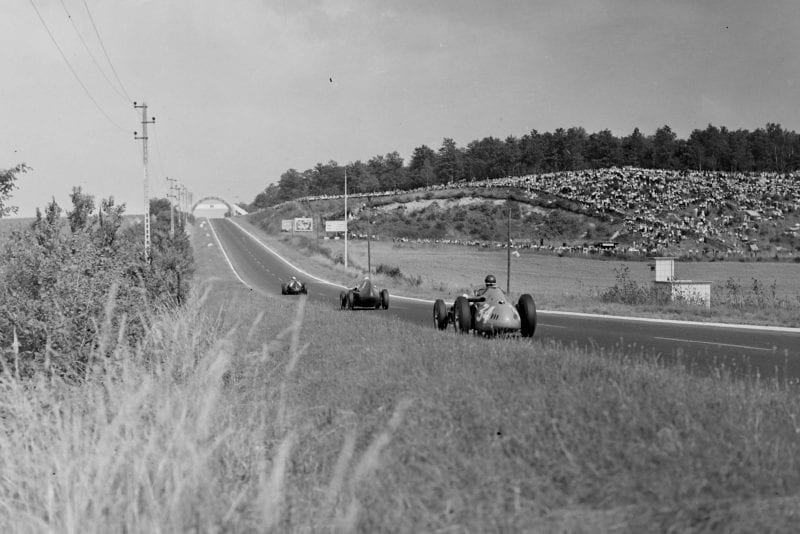
Jean Behra in a BRM P25, leads Stirling Moss in his Vanwall, and Juan Manuel Fangio’s Maserati 250F.
Motorsport Images
Behra was really making the Formula 2 world look a bit silly, for his car was nothing more than a modified sports car, actually being one of the Le Mans cars, and he was gradually drawing away from the whole might of proven Formula 2 runners. The pace was very fast and troubles were rife, Naylor going out with tyre trouble, Dennis Taylor’s Lotus running badly, Trintignant having engine trouble, Piotti’s Osca being in difficulties, as was Fast’s Osca.
Then on lap 10 Moss called at the pits to tell of failing oil pressure and after one more lap he was out of the race, so now Behra was completely unchallenged, for Collins in the Maranello “little Grand Prix car” could not cope with Stuttgart’s modified sports car. Wicken was driving hard and well to stay in front of all the private owners and was now third, followed by Burgess driving a fast smooth race, and behind him came McLaren and Henry Taylor having a terrific wheel-to-wheel battle.
By half distance, 15 laps, Behra was 20 seconds ahead of the Ferrari, and Wicken was still third followed by Burgess, both drivers looking extremely safe and sure, while behind them Maclaren and Taylor were still together. The rest of the runners had been lapped by the leaders. All hopes of a real motor race had now gone, and Behra went on and on with Collins not losing any ground, but not making up any either, while the rest followed on, the only relief from a procession being the continual battle between the two Coopers of Maclaren and Taylor, while the only Lotus left running was Leston’s which had eventually started a long way behind, his only hope being to cover sufficient laps to be qualified.
Behra’s victory with this “interim” Formula 2 Porsche was naturally a huge delight to all the advocates of air-cooling, an embarrasing shock to the Scuderia Ferrari and a real shaker to the British F2 boys, who thought they had got this type of racing well sewn-up. For the future health of Formula 2 this victory by Porsche is the finest thing that could have happened and might just be enough to encourage more interest in this type of racing in countries other than England.
F1 Race

Gerino Gerini (Maserati 250F) Chico Godia-Sales, (Maserati 250F) and Jo Bonnier (Maserati 250F) follow after the rest of the field at the start of the race.
Motosport Images
After a very brief pause the Formula 1 cars were wheeled out for the 44th French Grand Prix, the major event of the day, to be run over 50 laps a distance of 415 kilometres, almost a full-length Grand Prix by normal standards. The starting grid was quite a change from the usual run of things, for neither red nor green cars dominated the scene, there being a goodly mixture all the way through the field of 20 cars.
The noise of the start was really something, making the previous F2 race sound quite gentle, and it was Schell who accelerated away into the lead, with the rest of the field in hot pursuit, except von Trips who muffed his start and got away last. Before they reached the back straight Hawthorn had got the lead, and as the cars streaked across the horizon towards the Millais hairpin the red Ferrari was still leading and at the end of a really searing opening lap the order was Hawthorn, Schell, Musso, Moss, Brooks, Fangio, almost as quick as that, with very little to choose between any of them.
“The noise of the start was really something, making the previous F2 race sound quite gentle”
On lap 2 there was a big reshuffle behind Hawthorn who was still leading, for Musso took second place, followed by Colins, Brooks, Fangio, Behra, Schell and Moss and for a time it looked as if this was the way things were going to be, but on the fifth lap Collins had an exciting moment at the Muizon hairpin and went up the escape road. A metal air-scoop above the magneto had fallen off and dropped behind the brake-pedal, and by the time he had sorted things out he was way at the back of the field.
Meanwhile Hawthorn was pressing relentlessly ahead and it seemed that no one was going to catch him, though behind there was a different story, for Fangio, Schell, Behra and Moss were really mixing-it, battling for fourth place and closing on Musso and Brooks. As they came up the straight past the pits the two BRMs, the Vanwall and the Maserati were in a solid bunch and Fangio was within a foot or two of the pit wall as he tried to gain the lead.

Mike Hawthorn driving his Ferrari 246.
Motorsport Images
After only 10 laps Hawthorn was lapping the slower cars, as was Musso who was still keeping his team-mate in view, and as they went round the fast curving stretch beyond the pit area disaster struck, for poor Musso went into the right-hand bend too fast, slid and lost control and crashed badly, being taken to hospital with severe injuries.
On lap 12 Brooks who was second came slowly into the pits with a seizing gearbox, and though he restarted it was only for a few laps before he retired. The Moss, Fangio, Behra duel was still continuing but they had no hope of challenging the fixing Hawthorn, though they were now battling for second place.
Lewis-Evans, whose Vanwall was not running properly, was flagged in and in very quick time Brooks took over and then on lap 25 Fangio dropped out of the race for second place, as he called briefly at his pit to complain about the gear-change and this let Moss and Behra get well ahead, and also Schell, Trintignant and Collins go by the last making up ground fast after his incident.
Almost unnoticed due to the terrific hauling going on at the front of the field, was the progress of von Trips, who was steadily gaining places after his bad start. Graham Hill had already retired the new Lotus, due to a variety of troubles, among them the fact that the cockpit was becoming unbearably hot, while Allison with a 2.2-litre engine in one of the old cars was not getting anywhere, though Brabham with a similar engine in a works Cooper was going great gone.
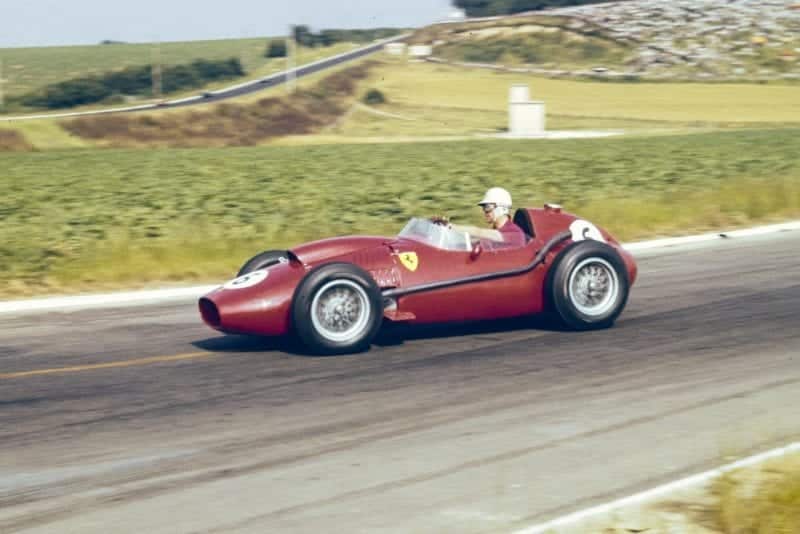
Wolfgang von Trips pilots his Ferrari 246.
Motorsport Images
Around half-distance more troubles were appearing, Trintignant stopping out on the circuit with a defective fuel pump, and Godia spinning off the course, unharmed but out of the race. Hawthorn was still in an unassailable position in the lead, with Behra and Maas still at it for second place, there seeming to be absolutely no difference at all between the performance or the two cars, and with only one bend on the circuit to bring out driver prowess, the neck-and-neck dice they were having was not surprising.
Schell arrived at the pits with a very hot BRM a water pipe having leaked and while he told everyone about it the mechanics tried to effect a repair. With the factory cars setting such a fantastic pace, the leader averaging over 200 kph it was not surprising that the few privately-owned Maserati were left a long way behind, and they were running in the order, Bonnier, Phil Hill, Shelby and Ruttman, the Indianapolis driver finding road-racing not an easy proposition, there being so much to do all at the same time.
The German driver von Trips was going remarkably well and was now lying in fourth place, followed by Collins after Schell’s pit stop, while Fangio was next, unable to make up for his brief pit stop, so fast was the pace; on lap 40 the Moss Behra duel came to and end when the BRM died out on the circuit, reported as fuel pump failure, and this left Moss in a comfortable second place, but quite unable to do anything about the royal progress of Hawthorn in the lead, who was now coming up past the pits shading his eyes with one band against the lowering sun. It was not a day for British cars, for just before Behra went out Brooks retired at the pits with the Lewis-Evans Vanwall, with smoke coming front the exhaust, the car never having run properly from the start of the race.
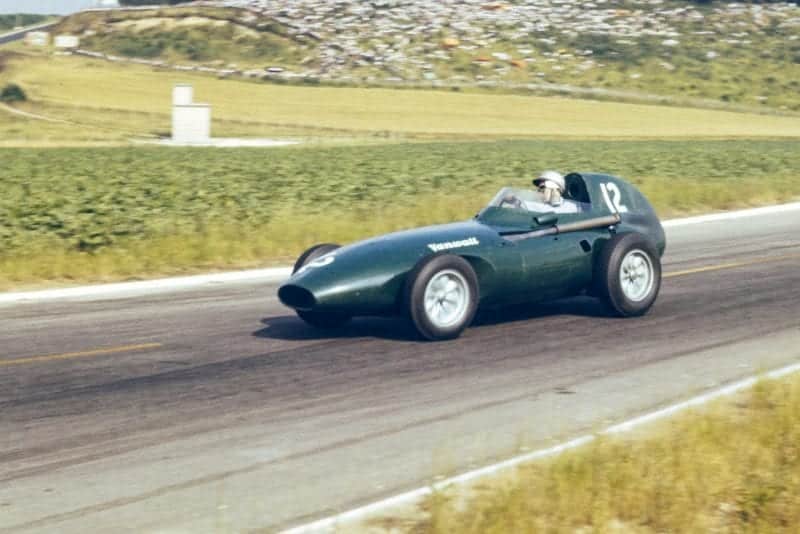
Stuart Lewis-Evans/Tony Brooks’ Vanwall.
Motosport Images
Just to show that he had the situation well in hand, for he was driving right on top of his form, Hawthorn set up a new race lap record on his 45th lap with a time of 2min 24.9sec and came sailing home a joyous, and jubilant victor of the French Grand Prix for the second time in his career; unfortunately, this joy was later marred by the unhappy news that poor Luigi Musso had succumbed to his injuries and Grand Prix racing had lost a courageous and brave driver who will certainly be remembered for his epic drive in the recent Monza 500-Mile race.
A soundly trounced Moss arrived second, the Vanwall never having given of its best, or else having met its match in the Dino Ferrari, and third after a really hard drive came von Trips. As Collins was awaited at the conclusion of his 50th lap he ran out of fuel just after the Thillois hairpin and pushed the car into the finish to gain fifth place behind Fangio who was placed fourth, having passed Collins while the Ferrari driver was pushing in. All the remaining runners had been lapped once or more.

Mike Hawthorn celebrating his victory at the French GP.
Motosport Images
Brief notes on the cars at Reims
- The Vanwall team had four identical ears, all having new oil tanks since their last appearance, this now being just behind the water radiator and having it hinged flap in the nose cowling to facilitate access to the tank filler. Previously it meant removing the bonnet to get at the filler. The car Moss drove was fitted with bracing struts from the top of the kingpins back to the chassis frame.
- All three BRM cars were 1958 models those of Behra and Trintignant having under-bonnet intakes for the Weber carburetters while Schell’s car retained the bonnet-top air scoop. Behra’s car was fitted with a new type of oil cooler on the right side of the engine, in place of the heat exchanger normally fitted.
- The Ferraris of Collins, Hawthorn and von Trips all had the heavier type Formula 1 chassis frames, while Musso’s car had the lighter Formula 2 type of frame. All cars had new front coil springs with telescopic shock-absorbers mounted inside the coils, there no longer being a screw adjustment at the top of the spring mounting. As at Spa all the cars had metal cowls over the carburetter intakes with forward-facing openings.
- The Maserati driven by Fangio was the one described last month in MOTOR SPORT being the new 1958 model. Bonnier borrowed Scarlatti’s 1957 car and lent his own earlier model to Phil Hill, while Gerini drove the ex-Piotti car, and Shelby and Ruttman had the two Centro-Sud cars, painted blue and white, and having new small capacity fuel tanks as used on the new works car.
- Graham Hill drove the 1958 Lotus with 1960cc Climax engine laid over on its side, and the propshaft running alongside the driving seat to a new arrangement of the Lotus 5-speed gearbox and differential unit. Allison had one of last year’s cars with a 2.2-Iitre engine.
- In the Formula 2 race Allison drove a 1958 Lotus this one having the engine lifted up and over to the left a few degrees as on the Le Mans Lotus Fifteen, engine layout still being down on power. For this race Hill had a 1957 Lotus with normal upright engine position.
- Moss drove the 1958 Walker Cooper and Trintignant the 1957 one. The Porsche was one of the Le Mans cars with the steering column positioned in the middle and a single seat mounted in the centre of the cockpit, side covers and a headfairing turning the car into a true single-seater. The engine was a normal RSK Spyder unit, and the chassis was unchanged from the Le Mans.
- The Ferrari F2 car was a Dino model developed from the first car that appeared last year at Reims, and had the latest telescope shock-absorbers as used on the F1 cars.
